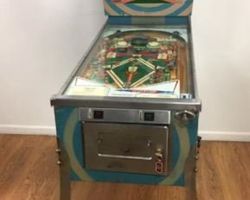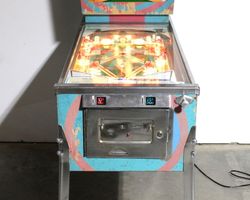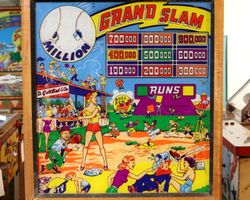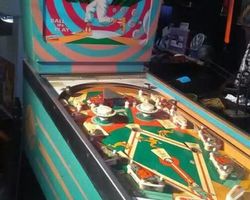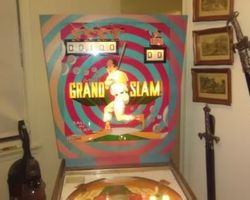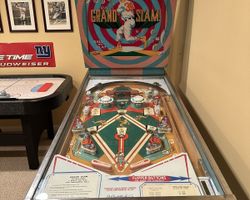Grand Slam
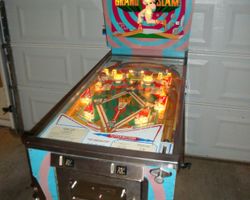
Average Prices: USD $300 to $1,100
Produced: April, 1953
Production Run: 1,800 units
Machine Type: Electro-mechanical
Players: 1
Design by: Wayne Neyens
Art by: Roy Parker
Gottlieb's "Grand Slam," released in April 1953, emerged during a dynamic period for the pinball industry, a time when electro-mechanical (EM) machines were at their peak of innovation and popularity. D. Gottlieb & Co., a prominent manufacturer of the era, consistently delivered machines that pushed design boundaries, and "Grand Slam" was a testament to this commitment. The machine's concept, design, animation, and mechanics were all masterminded by Wayne Neyens, a designer known for his inventive playfield layouts and challenging gameplay. The vibrant artwork, which defined the machine’s thematic identity, was crafted by Roy Parker, whose distinct style graced many Gottlieb tables. With a production run of 1,800 units, "Grand Slam" carved its niche in the market, appealing to both casual players and dedicated enthusiasts with its immersive baseball theme. This era saw pinball machines moving beyond simple score tallies to integrate deeper thematic elements, and "Grand Slam" embraced the national pastime with a mechanical ingenuity that allowed players to experience the ebb and flow of a baseball game on the playfield. Its release highlighted Gottlieb's ability to blend popular culture with engaging mechanical gameplay, setting a standard for sports-themed pinball.
Signature Features and Design
"Grand Slam" distinguishes itself through a cohesive design that translates the excitement of baseball into a pinball experience. A central feature is the ingenious "runs score system," which moves beyond conventional point accumulation to mirror the progression of a real baseball game. Players "load the bases" and "hit homers" to score runs, a mechanic that adds a layer of strategic depth uncommon for machines of its time. The playfield is populated with two flippers, three pop bumpers that energize ball movement, five passive bumpers, two slingshots for dynamic rebounds, four standup targets for precision shots, and three kick-out holes that reset or reward player action. A striking aspect of the lower playfield design is the presence of five distinct outlanes positioned between the flippers, a feature that significantly influences ball control and risk. Roy Parker's artistic contribution is undeniable, with the backglass and playfield artwork widely regarded as a pinnacle of pinball aesthetics. The baseball diamond motif, coupled with lively illustrations of players and spectators, creates a visual narrative that perfectly complements the gameplay. This artwork is not merely decorative; it enhances the immersive quality of the machine, drawing players into the theme and setting the stage for each pitch and hit. The combination of its thematic scoring and the detailed, expressive artwork makes "Grand Slam" immediately recognizable and engaging.
Playfield and Mechanics
The playfield layout of "Grand Slam" is designed with a deliberate flow that encourages continuous interaction and strategic thinking. At the top, a series of rollovers and targets typically lead into the upper playfield, where pop bumpers drive the ball with unpredictable force. Further down, multiple standup targets are strategically placed to demand accurate shots, often serving as prerequisites for advancing game objectives or earning specials. The central area features a series of passive bumpers and slingshots that redirect the ball, adding an element of randomness and requiring quick reactions from the player. Crucial to the game's identity are the three kick-out holes, each potentially representing a different base or scoring opportunity. Successfully hitting these can advance runners, score runs, or trigger bonus sequences. The lower playfield, with its two flippers and the five distinct outlanes, forms a challenging gatekeeping section. The wide spacing of these outlanes, while a point of contention for some, undeniably contributes to the game's high-stakes nature and rapid ball times. The design philosophy behind this layout emphasizes continuous engagement, presenting players with multiple objectives simultaneously. The artwork on the playfield, a vibrant tableau of a baseball stadium, reinforces the thematic experience. Bases, outfield lines, and player figures are integrated into the scoring areas, visually guiding the player toward their next objective. The lighting, typical of EM machines, highlights active targets and scoring opportunities, providing visual feedback that reinforces the gameplay loop and player immersion.
Gameplay Dynamics
"Grand Slam" distinguishes itself through its unique "runs score system," a departure from simple high scores. This system truly embodies the baseball theme: players aim to "load the bases" by hitting specific targets or sequences, and then "hit a homer" (or score a run) by completing another objective, often one of the kick-out holes. This thematic scoring elevates gameplay beyond mere point accumulation, compelling players to think in terms of strategic progression akin to a baseball game. The machine offers multiple ways to win replays and free games, adding layers of objectives that keep players engaged throughout their session. For instance, specific upper rollovers might contribute to a special, while a sequence of bottom rollovers (A, B, C) can unlock another reward. Additionally, collecting numbers sequentially from 1 to 9 often leads to significant bonuses or specials, providing a clear, progressive goal. The design ensures constant objectives, meaning that even on the last ball, there are still meaningful targets to pursue, contributing to high replayability. Player strategies often revolve around a calculated balance of aggressive shooting for high-value targets and careful flipper work to navigate the challenging lower playfield. Despite the inherent difficulty introduced by the widely spaced flippers and numerous outlanes, players are compelled to master precise shots to advance runners, score runs, and activate the various bonus features, making each game a strategic endeavor rather than a chaotic scramble.
Reception and Legacy
"Grand Slam" holds a distinct place among pinball machines of its era, eliciting a range of feedback from enthusiasts and collectors. Its strengths are frequently highlighted: the playfield layout is often described as stellar, contributing to a high degree of playability that belies the machine's vintage. Players consistently praise the multiple distinct paths to winning replays and free games, a feature that adds considerable depth and longevity to the gameplay experience. The "runs score system" garners particular acclaim for its ingenious integration of the baseball theme, allowing for strategic play reminiscent of a real game, such as the tactical loading of bases before attempting a "homer." This thematic scoring, coupled with the constant stream of objectives, ensures engagement until the very last ball. Roy Parker's artwork for "Grand Slam" is a consistent point of praise, often cited as a masterful example of pinball artistry, recognized for its vibrant composition and ability to perfectly capture the essence of the sport. However, the machine is not without its shared points of criticism. The most frequently mentioned challenge is the significant spacing between the flippers, which, combined with the five outlanes directly below, can lead to a high frequency of "center drains." This characteristic, while contributing to a challenging and sometimes swift game, is cited by some as a flaw that limits its broader appeal or prevents it from achieving universal "great" status. Despite this noted difficulty, "Grand Slam" is often considered among the premier woodrail machines, with some players describing it as "fantastic" or even "the best woodrail" they have encountered. Its legacy rests on its inventive scoring system, which pioneered a deeper thematic integration than many contemporaries, and its captivating Roy Parker artwork. "Grand Slam" endures as an example of Gottlieb's early design prowess, demonstrating how mechanical ingenuity and artistic vision could coalesce to create a compelling and enduring pinball experience.
Sponsored Links
 Ebay Listings
Ebay Listings
 Auction Results
Auction Results
| Cost | Location | Date |
|---|---|---|
| USD $1,800 |  Ohio, United States Ohio, United States |
12 September, 2024 |
| USD $1,100 |  Maryland, United States Maryland, United States |
30 May, 2024 |
| USD $1,700 |  United States United States |
08 November, 2023 |
| USD $2,999 |  California, United States California, United States |
11 September, 2019 |
| USD $510 |  Minnesota, United States Minnesota, United States |
03 October, 2018 |
| USD $700 |  New Jersey, United States New Jersey, United States |
29 June, 2018 |
| USD $650 |  Connecticut, United States Connecticut, United States |
05 March, 2018 |
| USD $275 |  United States United States |
18 December, 2017 |
| USD $550 |  California, United States California, United States |
08 March, 2017 |
| USD $660 |  Michigan, United States Michigan, United States |
08 December, 2016 |


Private Policy · Search Website · Contact Us
As an eBay Partner, we may earn a commission from qualifying purchases made through links on this site, at no additional cost to you.
All trademarks and copyrighted materials remain property of their respective owners. All other content copyright 2007 - 2025 Pinpedia.

